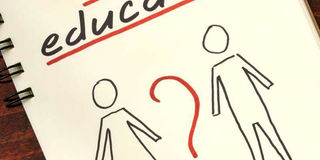Premium
Time is ripe for sex education in schools

Youth need sufficient information to protect themselves from HIV infection and unintended pregnancy.
Kenyan youth are having sex. The Kenya Demographic and Health Survey of 2014 (KDHS) showed that two out of 10 boys and girls have their first sexual encounter by age 15, and the number rises to about five out of 10 by age 18.
Majority of these youth do not have sufficient information or knowledge about sex to protect themselves from negative sexual and reproductive health outcomes like HIV infection or unintended pregnancy.
For example, the KDHS 2014 showed that four out of 10 Kenyans (40 per cent) of reproductive age reported not having comprehensive knowledge of HIV. Comprehensive knowledge means knowing that the risk of getting HIV can be reduced by using condoms and limiting sex to one uninfected partner, and knowing that a healthy-looking person can have HIV.
All available data points to the need for age-appropriate sex education as part of the school curriculum. Access to holistic, scientifically correct information about sexuality is our best bet in empowering adolescents and the youth to overcome sexual and reproductive health challenges, including unsafe abortions, new HIV infections and unintended teenage pregnancy. Furthermore, it is government policy, through the National Adolescent Sexual and Reproductive Health Policy of 2015, to develop an age-appropriate sexuality education framework.
Unfortunately, opponents of sexuality education resort to misinformation about sexuality education. One of their central arguments has been that providing such information to school-going Kenyan youth will be akin to giving the youth license to have sex.
THE SCIENCE
However, research contradicts this argument. The United Nations Educational Scientific and Cultural Organisation (UNESCO) published a review of 87 studies on sexuality education from around the world in 2009. The findings were issued in a publication titled International Technical Guidance on Sexuality Education, providing hard data on how sexuality education can influence behaviour. The publication shows that sexuality education is likely to delay sexual activity and reduce risky sexual behaviour. None of the 87 studies reviewed showed earlier sexual activity.
Another common argument against sexuality education is that age-appropriate sexuality education is likely to lead the youth away from our culture and traditions.
This argument is also not true as it is possible to create a culturally sensitive curriculum. In fact, the guidance issued by UNESCO and endorsed by the World Health Organisation on sexuality education, emphasises that sexuality education ought to be culturally sensitive.
VITAL INFORMATION
Age-appropriate comprehensive sexuality education is taught over several years, gradually introducing appropriate information consistent with the changing capacities of students. It provides scientifically accurate, curriculum-based information about human development, anatomy, and pregnancy. Also included in comprehensive sexuality education is information about sexually transmitted infections, including HIV.
The truth of the matter is that, growing up in the information age, Kenyan youth are at risk of misinformation and exposure to inappropriate sexual content. Many of them have access to mobile phones, the internet, and social media. Moreover, they have access to highly sexualised TV, print, and radio content.
Access to sexual and reproductive health information through age-appropriate sexuality education is vital.
We therefore implore the Ministry of Education and Ministry of Health to work fast and convene stakeholders, as envisioned in the National Adolescent Sexual and Reproductive Health Policy, to discuss and agree on an age-appropriate sexuality education curriculum.
Ms Samba is the country director at Deutsche Stiftung Weltbevoelkerung (DSW), a global development organisation


